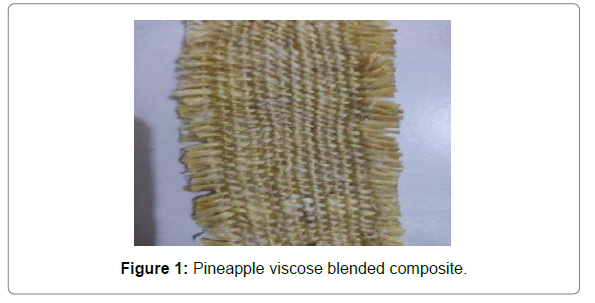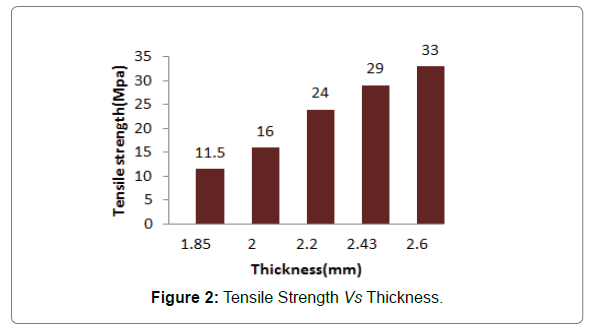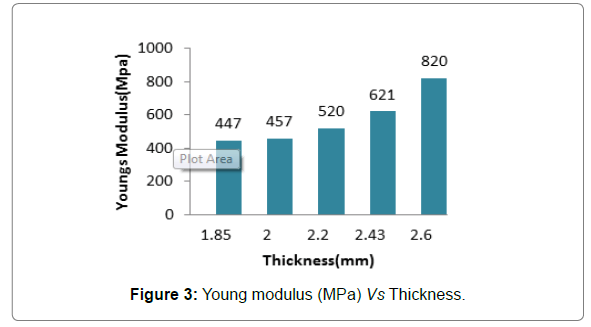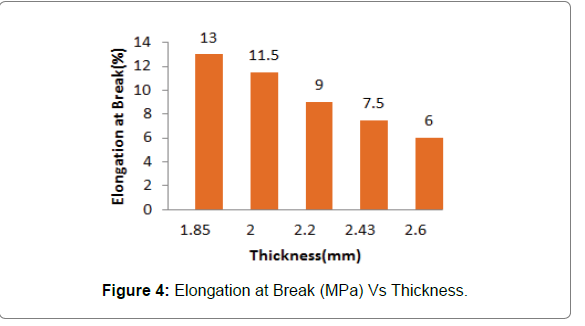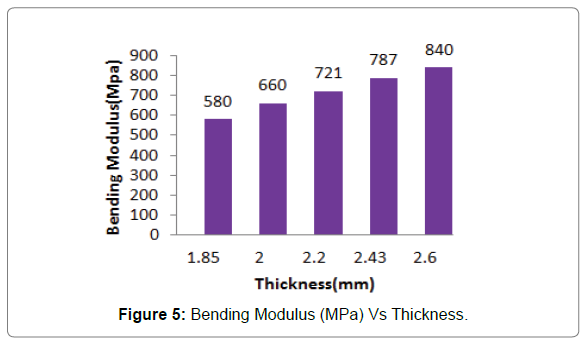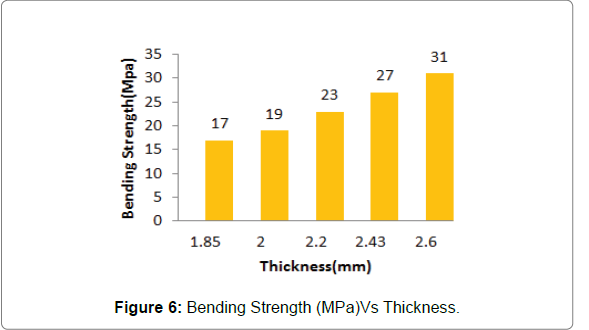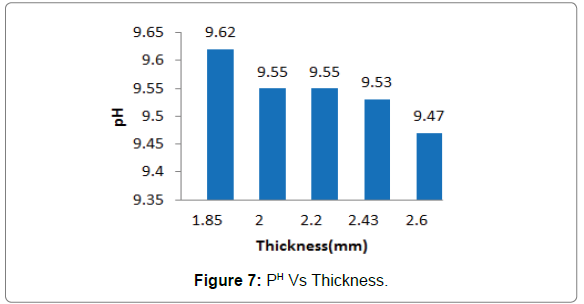Research Article, J Fashion Technol Textile Eng Vol: 9 Issue: 11
Investigation of Mechanical Properties of Pineapple-Viscose Blended Fabric Reinforced Composite
Rois Uddin Mahmud*
Lecturer, Department of Textile, BGMEA University of Fashion & Technology, Bangladesh
- *Corresponding Author:
- Rois Uddin Mahmud
Lecturer, Department of Textile, BGMEA University of Fashion & Technology, Bangladesh
E-mail: roisuddin@buft.edu.bd
Received Date: October 24, 2021; Accepted Date: November 22, 2021; Published Date: November 29, 2021
Citation: Mahmud RU (2021) Investigation of Mechanical Properties of Pineapple-Viscose Blended Fabric Reinforced Composite. J Fashion Technol Textile Eng 9:10. 228.
Copyright: © All articles published in Journal of Journal of Fashion Technology & Textile Engineering are the property of SciTechnol, and is protected by copyright laws. Copyright © 2020, SciTechnol, All Rights Reserved.
Abstract
As sustainable, ecofriendly, and environment-friendly world is coming to the near future, composites of regenerated fiber reinforced with natural fibers have gained increasing attention. In this research, Pineapple leaf fiber has been selected to make composite as it is being treated as wastage nowadays also. And viscose was selected to make a variation in the research field as no one has ever tried pineapple & viscose blended composite. Regenerated cellulosic fiber reinforced with natural fiber is using hugely as lack of natural fiber producing in Earth, giving almost same experience by using partial or less natural fiber. This article presents a research work carried out on Pineapple leaf fiber blended with Viscose composite reinforced With Epoxy resin. Pineapple viscose blended Composite is composed in a structure of 1 up 1 down plain wave design and epoxy resin are applied on them to make stability by the compression molding process. The tested result of the tensile strength (σ), young’s modulus, and Eb% is respectively 20.7Mpa, 579Mpa, and 9.4%. Some testing is also carried on it to differentiate the properties like bending strength 23.5Mpa, bending modulus 717.6Mpa, and avg. the pH of the composite is 9.54. In this article, there have different analytical parts to acknowledge the real condition of composite behaviors. Finally, some recommendation is also given where it can be used and where it will be suitable to apply. To develop the mechanical properties of this composite this research will continue in the future.
Keywords: Pineapple leaf fiber; Viscose; Composite; Epoxy; TS; Young’s Modulus
Introduction
Composite materials are created by mixing two or more materials that have superior desirable characteristics and mechanical performance than the elements individually. The composite’s initial applications date back to 1500 BC, when ancient Mesopotamian and Egyptian immigrants employed a combination of straw and mud to build sturdy and solid structures. The mix of straw and mud in a brick provides it excellent resistance to blending and ripping [1]. Composites characteristics are affected by three main factors: 1. the shape and placement of the reinforcement, 2. the components’ characteristics, 3. In contrast to the matrix, the volume of the strengthening portion. The composites feature is carried out by the distribution of the strengthening usually.
After World War II, composites were created by reinforcing synthetic fibers with polymer. In comparison to the characteristics of the included polymers, the mechanical properties of the resultant composites were considerably improved.
Early in the 1960s, polymer-based composites were extremely costly and only utilized in a few applications. Their prices rapidly reduced in the late 1990s, allowing them to be used in a wider range of applications [2]. The fiber-reinforced polymers (FRP) business was born out of the advancement and demand for composite materials [3]. A global source of renewable materials in agriculture. Pineapple leaf fiber (PALF) is a bio-composite with good mechanical characteristics. PALF has a greater percentage of cellulose (70- 82%) and a low Microfibrilar angle of 14°, indicating good specific strength and stiffness. Pineapple fiber has good electrical and thermal insulation properties, very good toughness, and at low cost wide commercial availability. Pineapple fiber quality varies depending on where it comes from, how it’s grown, and how it’s processed. The most widely used matrixes in composite production are thermosetting resins such as epoxy [4], polyester, polyurethane, and others, which have appropriate mechanical characteristics at a reasonable cost. ‘Natural fiber-reinforced composites show some disadvantages like hydrophobicity. So, a composite of hydrophilic reinforced fiber with low surface tension and with a hydrophobic or poor resistance to humidity absorption and high surface tension results in a lack of good interfacial adhesion, head to poor mechanical properties in comparison with pure polymer” [5].
Objectives of the Project
1. To make an alternative to conventional fabric.
2. To make a sustainable and eco-friendly material in textile.
3. To understand the process of reinforcement matrix and fiber for composites.
4. To extend knowledge of uses and selection of different composites based on the properties and characteristics.
5. To understand the importance of interacts in the behavior of composite materials.
6. To show the vital role played by composite materials in many industrial applications.
7. To understand how blending two or more fibers will improve the performance of the materials rather than a conventional one.
8. To work with a new idea.
9. To execute the innovative plan.
10. To research this particular material.
Several attempts have been undertaken in recent decades to produce materials that can replace current materials to provide superior mechanical and tri-biological characteristics for diverse applications. At that point, “the non-hybrid materials are replaced by fibers and materials such as glass, carbon, aramid fibers which are overwhelmingly used in automotive, aerospace, sporting, construction, and industries, etc”[6]. However, these materials have several drawbacks, including non-biodegradability, non-renewability, a high energy need for manufacturing, and even being damaging to the environment because the production of these materials emits massive amounts of carbon dioxide into the atmosphere every day. As a result, to overcome these obstacles, many researchers have attempted to investigate numerous natural fiber-reinforced composites with improved characteristics that can replace synthetic fibers in a variety of applications [7]. However, these materials have several drawbacks, including non-biodegradability, non-renewable. “By altering the fiber’s surface structure and energy, the issue can be solved by applying a physical or chemical treatment to the surface. Plasma treatment is one of the chemical treatments used to increase hydrophobicity and hydrophilicity in composite materials, as well as making modifications to mechanical properties and antibacterial activity. S. Mukhopadhyay, et al. used gamma radiation to temper a sisal fiber surface to increase adhesion between sisal fibers as reinforcement and polypropylene as the fiber composite’s matrix. Physical treatment, such as ionizing and non-ionizing rays, can improve surface cross-linking between both the matrix and the natural fiber, as well as diminish the hydrophilic character of the natural fiber due to the hydrophobic matrix” [5]. Researchers must create new forms of natural materials with diverse natural fibers derived from leaves, fruits, seeds, animals, and other sources as the need for novel materials with superior characteristics grows. A few key natural fibers’ mechanical qualities and features are discussed. As previously stated, natural fibers are corrected utilizing a variety of chemical and mechanical processes. Changing or improving the characteristics of natural fiber-based composites. To enhance the characteristics of natural fibers, polymers and other synthetic materials have been utilized alongside them. These concepts have influenced the development of several hybrid composites with natural fiber reinforcement. Analyzing the market shares of natural fibers, we can see an interesting fact. Table 1 showing pineapples do have not a big market share. It reflects that even in today’s world 95% of pineapple leaves are not being used as fiber. This is using as wastage. Developers are now more aware of the environmental issues of composite materials and are trying to find ways to minimize their impact on the environment. They are also recommending the use of natural fibers such as those found in the forests [8]. An increase in the length of the fibers can help in improving the surface treatment and the adhesion between them. This can be achieved by increasing the mix of the fibers with the resin matrix. Natural fiber composites are generally clumping and accumulating due to their long fibers. This causes them to lose their effectiveness in terms of their final performance [9]. Several Researchers have tried pineapple fiberbased composites which will lead to the idea being capitalized.
| Fibers | Producing Households (Million) | Earning/Household: 2018 |
|---|---|---|
| Cotton | 45 | -- |
| Jute | 06 | $200 |
| Wool | 05 | $3000 |
| Coir & bast | 01 | $1000 |
| Mode | ||
| Silk | 0.1 | -- |
| Ramie | 0.1 | -- |
| Sisal | 0.5 | -- |
| Others | 0.5 | -- |
| Total | 60 million | Enormous Variation: &50 to $50 Million |
Table 1: Townsend 2019.
Materials and Methods
To make composite different items are being used. As this research is based on natural fiber blended with viscose, therefore some specific items have been used. The primary items that are used are given below, Pineapple Leaf Fiber, Viscose Epoxy Resin, Hardener. Pineapple Leaf Fiber had been collected from Madhupur, Tangail, Bangladesh (Table 2). The pineapple plant is a widely cultivated plant that can be found in tropical and coastal regions in India. It is mainly used for its fruits. The land area of this plant is about 2250 square kilometers in India [10]. The leaves of the pineapple plant are very wasteful after they are harvested due to their size which grows up to 1–2m. It produces about 90 to 100 tons of leaves each year. The plant has good mechanical properties and possesses various fibers [7].
| C | O | N | Ca | P | Fe | K | Mg | Cu | O/C ratio |
|---|---|---|---|---|---|---|---|---|---|
| 73.13 | 24.17 | 2.70 | 0.00 | - | - | - | - | 0.00 | 0.33% |
| - | - | 6.4-10 | 2.5-10 | 0.1-0.18 | 0.06-0.11 | 2.89 | 0.33 | 0.002-0.02 | - |
Table 2: Elemental composition of the pineapple plant.
Pineapple tree is a short bush dark green color which bloom of leaf looks well decorated. Later it converts into 2 to 3-inch-wide and 3 ft. long discoidal and numerous coil arranged fibrous leaves edges and curved align with the section to maintain the rigidity of the leaf. Every pineapple tree has the same number of hexagonal sections on the surface shell and is independent of the size. Nowadays Malaysia is one of the large producers of Pineapple in Asia same as Hawaii. It produces a vast amount of wastage also, which is 384,673 MT in 2008. Pineapple fibers Productions are not even well driven out for industrial purposes without any practical addition and of easy availability [10]. Using the scrapers by hand the fibers were extracted. The various uses are in common textile, mats, automobiles, construction, etc. (Table 3).
| Cellulose content (%) | Hemi-cellulose (wt.%) |
Lignin content (%) |
Pectin (wt.%) |
Holo-cellulose | Moisture content (wt.%) |
Extractives | Ash (%) |
Fat & wax PALF composition |
|---|---|---|---|---|---|---|---|---|
| 70–82 | - | 5–12 | - | - | 11.8 | - | - | - |
| 69.5 | - | 4.4 | 1.1 | - | - | - | 0.9 | 3.3 |
| 70–80 | - | 5.0–12.7 | - | - | 11.8 | - | - | 3.3 |
| 74.33 | - | 10.41 | - | 80.68 | - | 6.66-8 | 4.73 | - |
Table 3: Chemical composition of PLAF.
The surface-modified and treated fibers are designed for making air-bag, conveyor belt cords, advanced composites, etc. [7]. “Pineapples known in Malaysia as nanas are used in different varieties for different purposes. Commercially they use red pineapple as well as green pineapple, for edible purposes. They choose Sarawak pineapple furthermore Morris pineapple also. Pineapple fruits contain many different elements. It is a source of different bioactive compounds, exactly in proteolytic enzymes. Bromelain and other cysteine proteases hold in a different part of pineapple” [10]. The applications of PALF in the composite material can be commercial, recyclable, and eco-friendly. Many natural fiber-reinforced composites exhibit less tensile strength than PALF/ER composite. With the increase of fiber loading and alkali treatment, good mechanical properties of the composite were noticed. But, with alkali treatment, the water uptake percentage progressed particularly. PALF is being used in the manufacture of eco-friendly goods. Composite products are for various purposes. Thus, PALF and its composite can easily replace synthetic fiber [11]. In Indonesia, there is a piece of equipment have invented that is used to spin short fiber even PALF into blended yarns. This machine was invented for spinning silk. This machine’s name is Jantra [12]. Viscose fiber is also known as rayon (manmade cellulosic fiber). Cellulose extracts from wooden pulp reacting with eighteen percent of Pineapple & Viscose blended yarn.
Method of Making Blended Yarn
The pineapple fibers and viscose fibers are brought together. Handloom was used to blend the yarn which is made from the mixture of pineapple and viscose. We fix the pineapple fiber and set the viscose in their body. Initially, the pineapple was not prepared because at room temperature the pineapple fibers were very brittle. At first, the fibers were dried in sunlight and when the humidity is less it was taken back from sunlight. Later, the pineapple fibers were kept in observation for 3 days. On these days the humidity, brittleness, breaking strength was checked. When all of these factors came to a suitable condition blending parts were started. To make yarns parallel a handloom was used where pineapple fibers are fixed. Then the viscose fibers were coped with it by hand. When the viscose was leveled with the pineapple fibers, these fibers were twisted together until these yarns are stable enough to stay free without a fist. In this way, pineapple and viscose yarn were blended.
Method of Making Composite Handloom was used to make the composite material. At first, Pineapple-Viscose blended yarns were fixed in Handloom in a warped way. Different sizes of fabrics were made for the project to use these in different steps such as execution, experiment, testing, exhibition, etc. So, several sizes of fabric were prepared which vary in height and width. In handloom one up and one down Plain fabric structure design was applied. To make a Plain design, the weft yarns were passed through the warp yarn. Thus the fabrication process is done. After fabrication, the stability of the fabric is not well. So to give it stability epoxy resin along with hardener were used. The composites were organized by the hand lay-up system. Pineapple Viscose fabric was considered as supporting material for pineapple viscose blended/ ER composites. The fabrics were cut to a Size of 12 cm × 12 cm and were taken in the cause of reinforcing. In a suitable environment, a glass plate of 15 cm × 15 cm dimensions was placed. For one of the main Samples 4 × 4 inches relevant to fabric weight, epoxy resin was put in a mug and 2% MEKP was added. An agitator was used to mix these two chemicals parallelly. The paper was poured by one-third of the mixture and over an area similar to that of the pineapple viscose blended composite was spread with a plastic spreader. After that one-ply, pineapple viscose composite material was positioned onto the epoxy resin mixture and a hand-roller was rolled over it. Further one-third of the mixture was also poured into the previous ply by practicing a similar process. Applying a similar process, epoxy resin solution was dispensed onto two plies of composite one after another. Then, it was slotted in between two pieces of my lot paper and it was driven over by a hand-roller. The entire sample was covered with two clear glass plates and a loaded weight of 7 kg on the collection for 3 hours. At last, the weight was discharged, and the two layers of my lot paper were detached from the Pineapple viscose blended composite.
The same process was used for all of the samples (Figure-1). Thus, pineapple viscose blended composite reinforced by epoxy resin were obtained which was treated with CS2 after the preparation, the white alkali cellulose changes to yellow and orange cellulose. Mixed caustic soda liquefies the Cellulose into a spinning solution or viscose, which is the method of process. Viscose is pumped through spinnerets which shower holes (5000–250000 holes) into a spinning bath, which remains thinned H2SO4, zinc sulfate as well as sodium sulfate the viscose thickens into hard filaments of cellulose that is pure. Viscose fibers having similar physiological properties rather less mechanical properties in comparison with cotton.
Testing of composite
Composite testing was done to find out reliability, material properties, and damage control. Another different testing is done to study the effects of variables on the composites (Anand, 2013). Composite materials and components require a series of mechanical tests to evaluate their properties under various conditions. These tests can be performed using a variety of mechanical testing instruments. Most fixtures are intended to meet exact materials testing standards. Top manufacturers and research organizations have been developed these standards over the years and then made their system into ASTM, ISO, EN, and other standards. Different auditing bodies such as Intertek; BV LTD; ITS LTD state performance criteria, for example, the effectiveness of the testing equipment.
According to Ian Mc Enteggart, who is the Composites Product and Applications Manager at Instron, Massachusetts, thinks the reasons for testing composites, are many, including:
Material Properties: Structural properties such as fiber orientation, laminate thickness, fiber volume, and fiber interior density and processing properties such as drying temperature and pressure can have a spectacular effect on composite materials on the mechanical properties. Mechanical testing is required to be aware of the effect these test results have on the finished composite.
Reliability: For service in high-performance applications in the Textile, automotive, and motorsport industries and commercial purposes, material testing is mandatory to prove the reliability of component properties.
Damage Tolerance: Testing is necessary to replicate real-world circumstances such as tool drops, small accidents, and manufacturing imperfections.
Research and Development: Testing is needed to examine variables that will affect mechanical properties, characteristics and to provide data for finite element analysis.
Sampling
The samples thicknesses were measured by digital slide calipers. The average results of three readings from different parts along the sample were taken for measuring each thickness. Most of the samples composites of pineapple viscose blended/ER nearly – 2.02 ± 0.02 mm. 4 samples were prepared with the same dimensions (4 × 4 inches) and 1 sample was prepared with the dimension of (18 × 4 inches) for irradiating with 5 different Test and Procedure.
Mechanical Tests
Mechanical properties like Young’s modulus (Y) and Tensile strength (TS) of the composites prepared were calculated by a universal testing machine (UTM) at the Bureau Veritas Bangladesh LTD, Nischintapur, Mouchak, Gazipur, and Dhaka, Bangladesh. The samples were prepared following the ASTM D 638 standard. Equations (4.1), (4.2), (4.3), (4.4), (4.5), (4.6) were used for measuring the tensile strength and Young’s modulus, elongation at break, Bending Modulus, Bending Strength respectively.
Tensile Strength
According to BS EN ISO 13934-2: 2014 the grab test method for measuring the Tensile strength of textile fabrics was done. Tensile testing is a vicious test method that provides information about tensile strength [13]. Provisions are made for wet testing. The grab test method is valid for woven, nonwoven, and felted fabrics. Textile fabrics having stretch more than 11 % is not applicable for this method including glass fabrics, knitted fabrics, and others. An 18-inch wide specimen was set middle in clamps of tensile testing machine and pressure applied on it until the fabric breaks. From machine screens, dials, autographic recording charts, or computer interfaced testing machines the values for the braking force and the elongation of the test specimen were recorded 50% RH and 23°C IPS conditions of samples.
Method
A specimen size 18”x4” was taken.
The specimen was marked at 2” from the edge of the fabric to assist in clamping it so that the same sets of threads are clamped in jaws. From 2” edge two jaws are fixed on both sides of the specimen so that 2” of fabric is stressed. Used gauge length of 14” and the speed is adjusted so then the sample is broken in 17 seconds. The relation was approximate:
Tensile strength is measured by dividing the load to break by the original least cross-sectional area value. The result was counted in Mega Pascal (MPa) and resulted in three significant figures

Where,
S = Tensile Strength
F = Force Applied to break
A = The cross-Sectional Area
Result of avg. TS-20.7 Mpa
Young’s Modulus Test
ASTM C 1557 is the regular test method for determining Young’s modulus of Fabric, glass, carbon, and other fibers at a certain temperature. All specimens were loaded to rupture, at a continuous rate of crosshead dislodgment. The composite was set in the testing machine and then pressured to break down at a continuous crosshead dislodgment rate. A test result was measured in which a composite crash doesn’t occur in the gripping region. Young’s modulus was measured from the linear area of the stress vs strain curve of composite.
Young’s modulus was evaluated from the load augmentation and matching addition rise, between two ends on the line as distant as possible, by using the following formula:
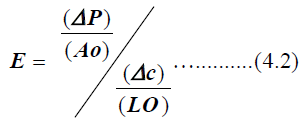
Where,
E = Young’s Modulus,
ΔP = load increment,
Ao = original cross-sectional area,
Δc = extension increment, and
LO = original gauge length.
Result of avg. young’s Modulus-579Mpa
Young’s modulus may also be calculated through the deviation diagram by joining graphically a straight line to the proper points. From this line, the deviation increase equivalent to a given stress growth can be read and substituted in the following equation:
Young’s modulus

Where,
E = Young’s Modulus
A = stress increment,
B = trial modulus, and
C = deviation increment.
Elongation at Break Test
Elongation at Break is measured according to the ASTM-D-5034 method [14]. Determination of ductility is elongation at break. The method by which we obtain elongation is by pulling a specimen in pressure until the break. Elongation is calculated in percentage of its original testing length and is expressed by,
EB%= ×100%............. ..(4.4)
Where,
EB% = Elongation at break
ΔLb = extension at breakpoint
L0 = original length of the sample
Result of avg. Elongation at break–9.4%
Bending Modulus Test
The bending strength (BS) was determined using universal tensile testing equipment following ISO standard (ISO 14125). The 4.5 Equation was used to calculate the bending strength.

Where,
σ = Bending strength
F = Load at the breakpoint
L = The support spun length
b= width
d = thickness
Result of avg. Bending Modulus –717.6Mpa
Bending Strength Test
“A bending test was carried out for determining bending modulus (BM) using the same universal tensile testing machine according to ISO standard (ISO 14125)” [11, 15].

Where,
w = Width of Sample
h = Sample height
L = Distance betn the two outer supports
d = Deflection due to load
F = Applied at the middle of the sample
Result of avg. Bending Strength-23.5Mpa
pH Test
PH test was done from Libas Textile Ltd. Five have done a test on the sample weight of 2g each. The sample was cut into small pieces so that there is no contamination while testing. After testing 5 different results have been achieved. Average of – 9.54
Results and Discussions
In this research pineapple viscose blended/ER composite showed avg. tensile strength 20.7 MPa which is quite surprising. As it is expected that, after blending the tensile strength will increase as epoxy resin is very good enough to strengthen the mechanical properties. Though, the avg. the thickness of the normal composites is less than pineapple viscose blended composite which is nearly 2.21 mm. That shows after blending the tensile strength changed dramatically. That means viscose is the Primary cause of declining tensile strength. The secondary cause of reducing tensile strength was using epoxy resin because in pineapple polyester composite the tensile strength increased in comparison with the other composite. So, by using polyester resin the tensile strength could increase. The young’s modulus we found is a similar result as tensile strength results showed. In this research, we find result avg.579 MPa which is below the expected. Reasons for unexpected young’s modulus results are as same as the tensile strength’s stated earlier (Figures 2-7).
By using different surface treatments young’s modulus result could increase. The avg. result of elongation to break properties of composite is nearly 9.4% for the composite. In general, the different composite shows different results as per their properties. That’s why the elongation at break is a much more normal one. Bending Modulus is one of the most important properties that a de facto matter for composite. It determines how ductile a composite can be. Pineapple viscose blended composite has an avg. bending modulus of 717.6 MPa. Bending Modulus and Bending Strength is related to bending strength. The bending strength avg. the result shows that it can bear a load of 23.5 MPa. Bending modulus has a significant role as the fabric has to be passed this test a must? From these bar charts, a common status has been noticed. As the thickness is increasing the mechanical properties except for elongation to break is also increasing. That means, the more it is thicker the more it is stronger. Pineapple viscose blended yarn count in a laboratory was also measured. The yarn count of composite is 14 Ne which is a little more in comparison with other yarn. And the result of pH test results on average 9.54.
Conclusions
As the demand for pineapple has increased, the need for more research on the utilization and production of PALF has also increased. This is the reason why the research works related to the PALF should be carried out. Although the research on PALF showed that it can capture a significant market share among natural fibers, there is still a need for more supply in the industry. Pineapple viscose blended composite reinforced with epoxy resin has a huge potential in the future as an eco-friendly and biodegradable society is the next solution in the modern world. Using conventional fabric or metals people will choose composite material. After becoming commercially viable most of the composite will reign in the market. Though this is the initial step towards pineapple & viscose blended composite reinforced with epoxy resin research, further research will increase this research effectiveness.
References
- Ngo T-D ( 2018) "Natural fibers for sustainable bio-composites." Natura and artificial fiber-reinforced composites as renewable sources : 107-126.
- Agoudjil B, Benchabane A, Boudenne A, Ibos L, & Fois M (2011) Renewable materials to reduce building heat loss: Characterization of date palm wood. Energy Build 43: 491-497.
- Ngo T D (2020) Introduction to composite materials. Composite and Nanocomposite Materials From Knowledge to Industrial Applications.
- Wable V, Biswas P K, Moheimani R, Aliahmad N, & Omole P et.al (2021) Engineering the electrospinning of MWCNTs/epoxy nanofiber scaffolds to enhance physical and mechanical properties of CFRPs. Compos Sci Technol 213: 108941.
- Motaleb K Z M, Islam M S, Milašius R (2019) Effect of gamma radiation on the mechanical properties of natural fabric reinforced polyester composites. Fibres Text East Eur: 88-93.
- Bahrami M, Abenojar J, Martínez M Á (2020) Recent Progress in Hybrid Biocomposites: Mechanical Properties, Water Absorption, and Flame Retardancy. Mater 13: 5145.
- Thyavihalli Girijappa Y G, Mavinkere Rangappa S, Parameswaranpillai J, Siengchin S (2019) Natural fibers as sustainable and renewable resource for development of eco-friendly composites: a comprehensive review. Front Mater 6: 226.
- Al-Oqla F M, Sapuan S (2018) Natural fiber composites. Mater Select: 23-48.
- Al-Oqla F M, Sapuan S M (2015) Polymer selection approach for commonly and uncommonly used natural fibers under uncertainty environments. Jom 67: 2450-2463.
- Asim M, Abdan K, Jawaid M, Nasir M, and Dashtizadeh Z et al. (2015) A review on pineapple leaves fibre and its composites. Int J Polym Sci: 1-16.
- Motaleb K Z M, Shariful Islam M, Hoque M B (2018) Improvement of physicomechanical properties of pineapple leaf fiber reinforced composite. Int J Biomater 1-7.
- Yusof Y, Yahya S A, Adam A (2014) A new approach for PALF productions and spinning system: The role of surface treatments. J Adv Agric Technol 1: 161-164.
- Saba N, Jawaid M, Sultan M T H (2019) An overview of mechanical and physical testing of composite materials. Mechan Phys TestBiocomposite, Fibre-Reinforced Composite Hybrid Composite: 1-12.
- Manimaran P, Senthamaraikannan P, Sanjay M R, Marichelvam M K, Jawaid M (2018) Study on characterization of Furcraea foetida new natural fiber as composite reinforcement for lightweight applications. Carbohydr Polym 181: 650-658.
- Sreekala M S, Kumaran M G, Thomas S (1997) Oil palm fibers: Morphology, chemical composition, surface modification, and mechanical properties. J Appl Polym Sci 66: 821-835.
 Spanish
Spanish  Chinese
Chinese  Russian
Russian  German
German  French
French  Japanese
Japanese  Portuguese
Portuguese  Hindi
Hindi 